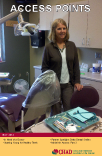HIV program emphasizes speed, ease of test
National testing day scheduled for June 27
People might be afraid to find out, lack insurance to pay or fear the social stigma. But what if results of an HIV test took minutes instead of weeks, was free and took one prick of the finger? |
Testing Times |
That describes the procedure for this year's national HIV testing day June 27. At Falls Community Health, where people can test locally, the hope is that unscheduled appointments and quicker results mean more tests and thus more safety.
"Accessibility and cost," state epidemiologist Dr. Lon Kightlinger said of some of the primary reasons that drive test recipients. "People fear about making a doctor's appointment ... if they have to wait, some will chicken out."
Perhaps adding more urgency to this year's testing event is the statistic that last year, South Dakota recorded its highest number of positive HIV tests in 15 years, with 35 cases. That's the second-highest number in 26 years of testing.
Reasons for a rise in positive tests are not entirely known and probably are based on several factors, but Kightlinger said cases of the virus have been steady in South Dakota, averaging about 25 new cases of HIV a year.
But a trend has developed about a growing lack of awareness of the disease, said HIV prevention nurse Deb Olsen of Falls Community Health. In 2004, 70 percent of people who took an HIV test said they heard about the disease through the media or other sources. In 2009, the number dipped to 45 percent.
"Now we're wondering that because there are treatments, people will think they'll be fine, but AIDS is for life and kills you," she said.
The official testing day offers same-day appointments and results, but spikes in appointments for the day are uncommon, in part because of everyday testing possibilities in Sioux Falls and a campaign emphasizing year-round awareness, said Heather Durband, chairwoman of the Sioux Falls AIDS fund.
South Dakota has the third-lowest HIV rate in the nation, with about 400 people in the state living with the virus.
"We usually tend to forget about the disease," Durband said. "But (the day) is a reminder for everyone at risk to get tested, to know their status."

